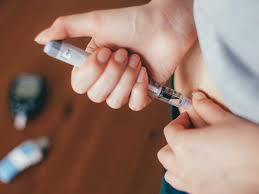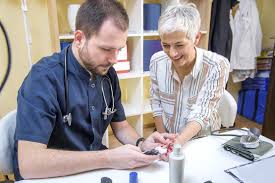 ..............................................................................................................................................................
..............................................................................................................................................................
 Understanding Insulin
Resistance
Understanding Insulin
Resistance
When the body blocks insulin from doing its
job
By Erika Gebel, PhD
The
bodies of many people with diabetes are fighting a quiet war against the
essential hormone insulin.
This
conflict is called insulin resistance, and while it's a hallmark of prediabetes and type 2 diabetes, it can also affect those
with type 1.
 Just why
a person fails to respond properly to insulin is something of a mystery.
Just why
a person fails to respond properly to insulin is something of a mystery.
But there
are ways to make the body more receptive to insulin, which can help prevent or
ameliorate diabetes.
Building
Up Resistance
In people
who have neither diabetes nor insulin resistance, eating a typical meal will
cause blood glucose levels to rise, triggering the pancreas to produce insulin.
The
hormone travels through the body and induces fat and muscle cells to absorb
excess glucose from the blood for use as energy.
As the
cells take up glucose, blood glucose levels fall and flatten out to a normal
range.
 Insulin
also signals the liver — the body's glucose repository — to hold on to its
glucose stores for later use.
Insulin
also signals the liver — the body's glucose repository — to hold on to its
glucose stores for later use.
However,
people with insulin resistance, also known as impaired insulin sensitivity,
have built up a tolerance to insulin, making the hormone less effective.
As a
result, more insulin is needed to persuade fat and muscle cells to take up
glucose and the liver to continue to store it.
In
response to the body's insulin resistance, the pancreas deploys greater amounts
of the hormone to keep cells energized and blood glucose levels under control.
(This is why people with type 2 diabetes tend to have elevated levels of
circulating insulin.)
The
ability of the pancreas to increase insulin production means that insulin
resistance alone won't have any symptoms at first.
Over
time, though, insulin resistance tends to get worse, and the pancreatic beta
cells that make insulin can wear out.
Eventually,
the pancreas no longer produces enough insulin to overcome the cells'
resistance. The result is higher blood glucose levels (prediabetes) and,
ultimately, type 2 diabetes.
Insulin
has other roles in the body besides regulating glucose metabolism, and the
health effects of insulin resistance are thought to go beyond diabetes.
For
example, some research has shown that insulin resistance, independent of
diabetes, is associated with heart disease.
Behind
the Battle
Scientists
are beginning to get a better understanding of how insulin resistance develops.
For
starters, several genes have been identified that make a person more or less
likely to develop the condition.
 It's also
known that older people are more prone to insulin resistance.
It's also
known that older people are more prone to insulin resistance.
Lifestyle
can play a role, too; being sedentary, overweight, or obese increases the risk
for insulin resistance.
Why? It's
not clear, but some researchers theorize that extra fat tissue may cause
inflammation, physiological stress, or other changes in the cells that
contribute to insulin resistance.
There may
even be some undiscovered factor produced by fat tissue, perhaps a hormone,
that signals the body to become insulin resistant.
Doctors
don't usually test for insulin resistance as a part of standard care.
In
clinical research, however, scientists may look specifically at measures of
insulin resistance, often in an effort to study potential treatments for
insulin resistance or type 2 diabetes.
They
typically administer a large amount of insulin to a subject while at the same
time delivering glucose to the blood to keep levels from dipping too low.
The less
glucose needed to maintain normal blood glucose levels, the greater the insulin
resistance.
Insulin
resistance comes in degrees, with important health implications for people with
diabetes.
The more
insulin resistant a person with type 2 is, the harder it will be to manage the
disease because more medication is needed to get enough insulin in the body to
achieve target blood glucose levels.
Insulin
resistance isn't a cause of type 1 diabetes, but people with type 1 who are
insulin resistant will need higher insulin doses to keep their blood glucose
under control than those who are more sensitive to insulin.
As with
type 2, people with type 1 may be genetically predisposed to become insulin resistant.
Or they
may develop resistance due to overweight.
Some
research indicates that insulin resistance is a factor in cardiovascular
disease and other complications in people with type 1.
Counterattack
While it
may not be possible to defeat insulin resistance entirely, there are ways to
make the body cells more receptive to insulin.
Getting
active is probably the best way; exercise can dramatically reduce insulin
resistance, in both the short and long terms.
In
addition to making the body more sensitive to insulin and building muscle that
can absorb blood glucose, physical activity opens up an alternate gateway for
glucose to enter muscle cells without insulin acting as an intermediary.
This
reduces the cells' dependence on insulin for energy.
This mechanism
doesn't reduce insulin resistance itself, but it can help people who are
insulin resistant improve their blood glucose control.
Weight
loss can also cut down on insulin resistance.
 No one
diet has been proved to be the most effective.
No one
diet has been proved to be the most effective.
Some
evidence suggests, though, that eating foods that are low in fat and high in
carbohydrates can worsen insulin resistance.
Research
has also shown that people who undergo weight-loss surgery are likely to become
significantly more sensitive to insulin.
No
medications are specifically approved to treat insulin resistance.
Yet diabetes medications like metformin and
thiazolidinediones, or TZDs, are insulin sensitizers that lower blood glucose,
at least in part, by reducing insulin resistance.
While
fighting an invisible foe may seem daunting, there are effective tactics to
combat insulin resistance.
Losing
weight, exercising more, or taking an insulin-sensitizing medication may get
the body to bend once again to insulin's will, bringing about good blood
glucose control and better health.
The
Diabetes Forecast brand provides accurate, timely, and friendly information
about all aspects of living with diabetes or prediabetes, including food,
fitness, weight loss, medications, research, and well-being for the entire
family. Hope and inspiration, including real-life stories and reader-submitted
content are other key ingredients in the editorial mix. Diabetes Forecast
content address the broad spectrum of people living with diabetes— from those
newly diagnosed with diabetes to people who have been living with the condition
for decades.
In 2013, Diabetes Forecast magazine was awarded the Best Publication
Redesign Gold award from the American Society of Healthcare Publication
Editors. Diabetes Forecast is also included in the National Diabetes Education
Program’s Diabetes HealthSense website.











